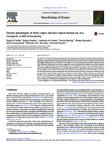Distinct phenotypes of three-repeat and four-repeat human tau in a transgenic model of tauopathy
| dc.contributor.author | Sealey, MA | |
| dc.contributor.author | Vourkou, E | |
| dc.contributor.author | Cowan, CM | |
| dc.contributor.author | Bossing, Torsten | |
| dc.contributor.author | Quraishe, S | |
| dc.contributor.author | Grammenoudi, S | |
| dc.contributor.author | Skoulakis, EMC | |
| dc.contributor.author | Mudher, A | |
| dc.date.accessioned | 2017-08-07T13:17:50Z | |
| dc.date.available | 2017-08-07T13:17:50Z | |
| dc.date.issued | 2017-09 | |
| dc.identifier.issn | 0969-9961 | |
| dc.identifier.issn | 1095-953X | |
| dc.identifier.uri | http://hdl.handle.net/10026.1/9686 | |
| dc.description.abstract |
Tau exists as six closely related protein isoforms in the adult human brain. These are generated from alternative splicing of a single mRNA transcript and they differ in the absence or presence of two N-terminal and three or four microtubule binding domains. Typically all six isoforms have been considered functionally similar. However, their differential involvement in particular tauopathies raises the possibility that there may be isoform-specific differences in physiological function and pathological role. To explore this, we have compared the phenotypes induced by the 0N3R and 0N4R isoforms in Drosophila. Expression of the 3R isoform causes more profound axonal transport defects and locomotor impairments, culminating in a shorter lifespan than the 4R isoform. In contrast, the 4R isoform leads to greater neurodegeneration and impairments in learning and memory. Furthermore, the phosphorylation patterns of the two isoforms are distinct, as is their ability to induce oxidative stress. These differences are not consequent to different expression levels and are suggestive of bona fide physiological differences in isoform biology and pathological potential. They may therefore explain isoform-specific mechanisms of tau-toxicity and the differential susceptibility of brain regions to different tauopathies. | |
| dc.format.extent | 74-83 | |
| dc.format.medium | Print-Electronic | |
| dc.language | en | |
| dc.language.iso | eng | |
| dc.publisher | Elsevier BV | |
| dc.subject | 3R tau | |
| dc.subject | 4R tau | |
| dc.subject | Alzheimer's disease | |
| dc.subject | Drosophila | |
| dc.subject | Isoforms | |
| dc.subject | Tauopathy | |
| dc.title | Distinct phenotypes of three-repeat and four-repeat human tau in a transgenic model of tauopathy | |
| dc.type | journal-article | |
| dc.type | Journal Article | |
| plymouth.author-url | https://www.webofscience.com/api/gateway?GWVersion=2&SrcApp=PARTNER_APP&SrcAuth=LinksAMR&KeyUT=WOS:000406734300006&DestLinkType=FullRecord&DestApp=ALL_WOS&UsrCustomerID=11bb513d99f797142bcfeffcc58ea008 | |
| plymouth.volume | 105 | |
| plymouth.publication-status | Published | |
| plymouth.journal | Neurobiology of Disease | |
| dc.identifier.doi | 10.1016/j.nbd.2017.05.003 | |
| plymouth.organisational-group | /Plymouth | |
| plymouth.organisational-group | /Plymouth/Faculty of Health | |
| plymouth.organisational-group | /Plymouth/Faculty of Health/Peninsula Medical School | |
| plymouth.organisational-group | /Plymouth/REF 2021 Researchers by UoA | |
| plymouth.organisational-group | /Plymouth/REF 2021 Researchers by UoA/UoA03 Allied Health Professions, Dentistry, Nursing and Pharmacy | |
| plymouth.organisational-group | /Plymouth/Research Groups | |
| plymouth.organisational-group | /Plymouth/Research Groups/Institute of Translational and Stratified Medicine (ITSMED) | |
| plymouth.organisational-group | /Plymouth/Research Groups/Institute of Translational and Stratified Medicine (ITSMED)/CBR | |
| plymouth.organisational-group | /Plymouth/Users by role | |
| plymouth.organisational-group | /Plymouth/Users by role/Academics | |
| dc.publisher.place | United States | |
| dcterms.dateAccepted | 2017-05-10 | |
| dc.identifier.eissn | 1095-953X | |
| dc.rights.embargoperiod | No embargo | |
| rioxxterms.versionofrecord | 10.1016/j.nbd.2017.05.003 | |
| rioxxterms.licenseref.uri | http://www.rioxx.net/licenses/all-rights-reserved | |
| rioxxterms.licenseref.startdate | 2017-09 | |
| rioxxterms.type | Journal Article/Review | |
| plymouth.oa-location | http://www.sciencedirect.com/science/article/pii/S0969996117301067?via=ihub |


